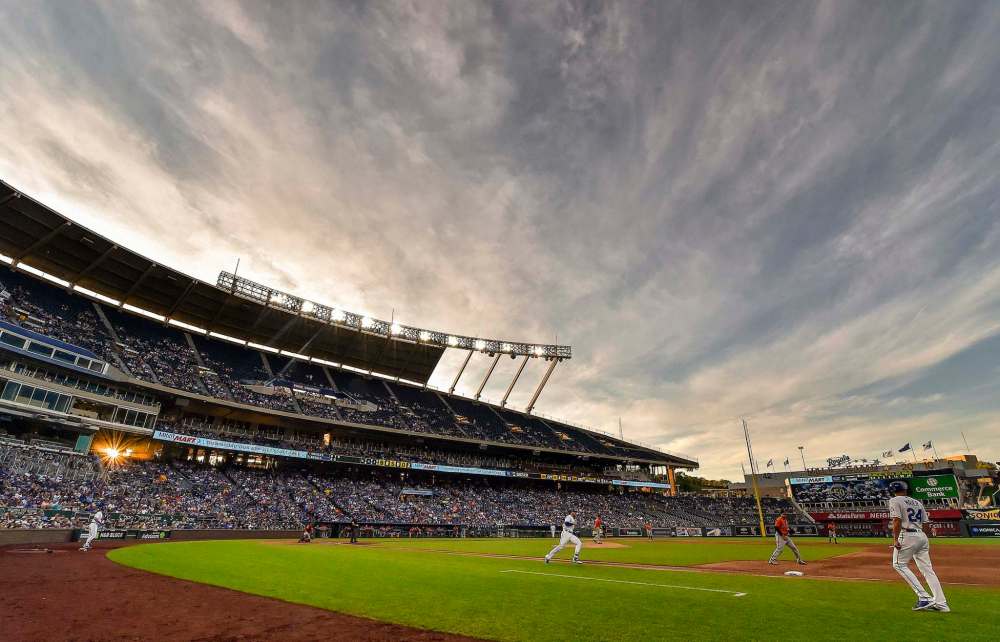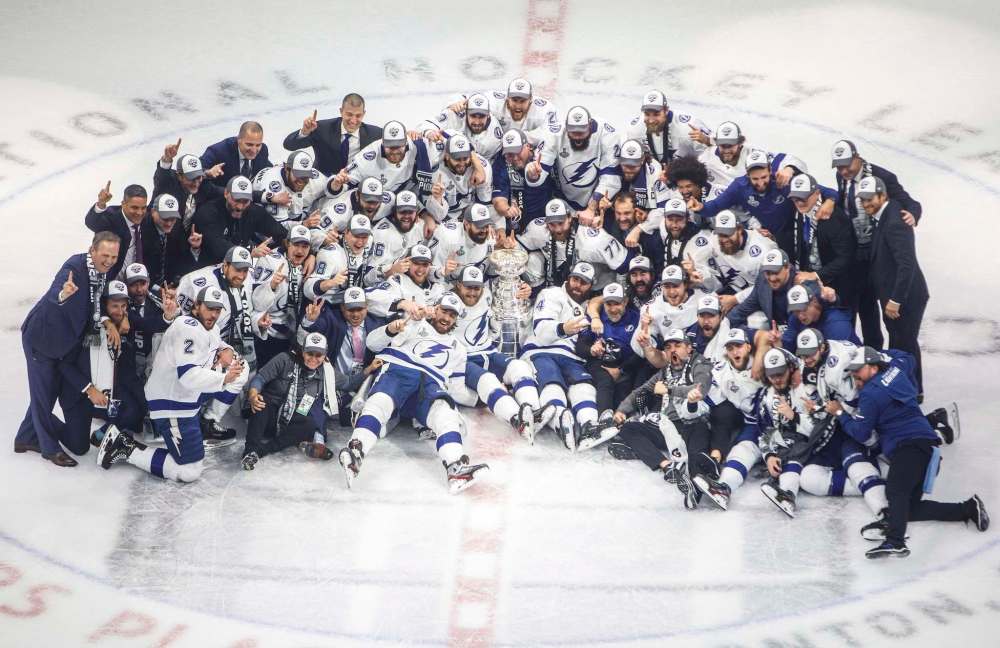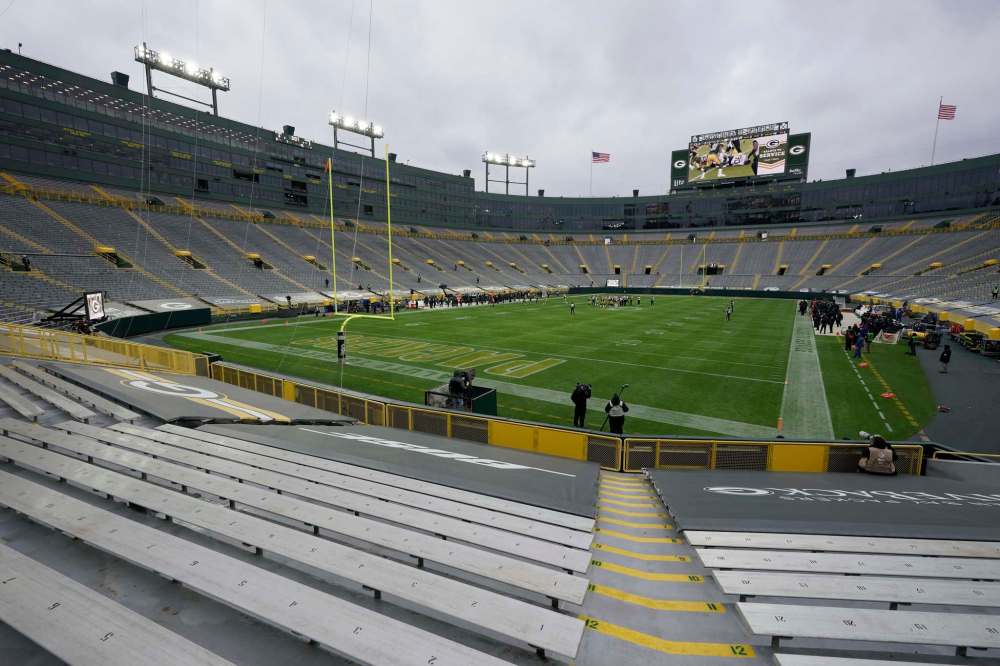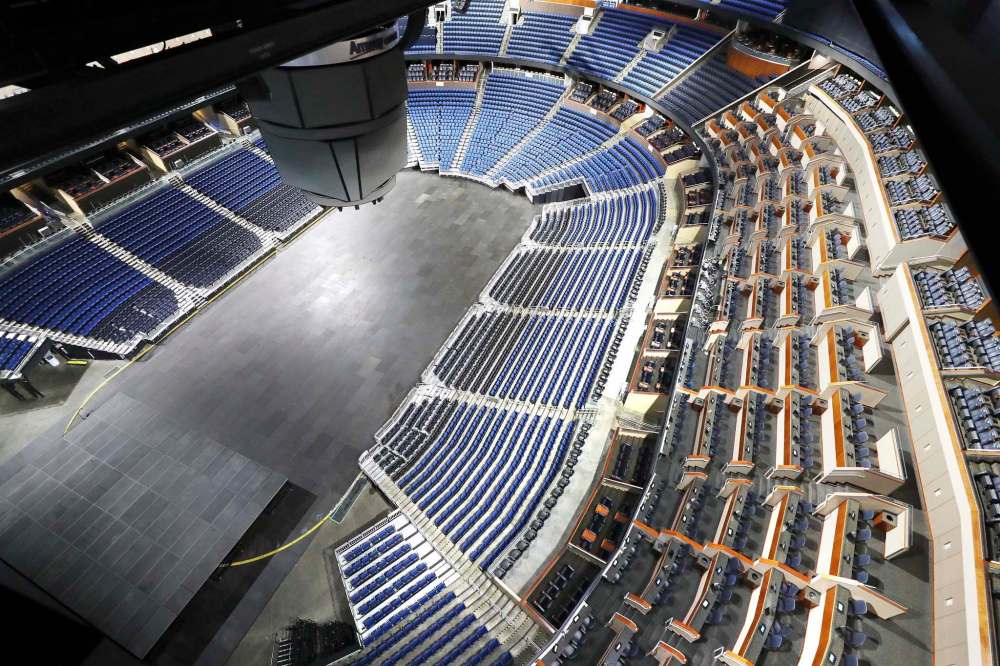Pop goes the bubble? Nervous team owners and TV executives are facing historic-low ratings for sports broadcasts; trouble was already brewing and then, well... 2020
Read this article for free:
or
Already have an account? Log in here »
To continue reading, please subscribe:
Monthly Digital Subscription
$0 for the first 4 weeks*
- Enjoy unlimited reading on winnipegfreepress.com
- Read the E-Edition, our digital replica newspaper
- Access News Break, our award-winning app
- Play interactive puzzles
*No charge for 4 weeks then price increases to the regular rate of $19.00 plus GST every four weeks. Offer available to new and qualified returning subscribers only. Cancel any time.
Monthly Digital Subscription
$4.75/week*
- Enjoy unlimited reading on winnipegfreepress.com
- Read the E-Edition, our digital replica newspaper
- Access News Break, our award-winning app
- Play interactive puzzles
*Billed as $19 plus GST every four weeks. Cancel any time.
To continue reading, please subscribe:
Add Free Press access to your Brandon Sun subscription for only an additional
$1 for the first 4 weeks*
*Your next subscription payment will increase by $1.00 and you will be charged $16.99 plus GST for four weeks. After four weeks, your payment will increase to $23.99 plus GST every four weeks.
Read unlimited articles for free today:
or
Already have an account? Log in here »
Hey there, time traveller!
This article was published 27/11/2020 (1840 days ago), so information in it may no longer be current.
Quick — what has been the single-best performing asset class of the last two decades?
Stocks? It’s been a great run, for sure. But no. Real estate? Ditto. Bonds, commodities, money markets? No, no and no.
The most consistent-performing asset class for the last 20 years has been the rarest one of all — owning a pro sports franchise.
Owners in three of the four major professional sports leagues in North America — the NFL, the NBA and Major League Baseball — have all achieved double-digit compound annualized growth rates since 2000.
And even the one league that didn’t hit double digits — the NHL — averaged a 7.8 per cent annualized growth rate, which is still better than how the markets performed.
It is one of life’s cruel ironies that billionaire men who least need the money — and it’s almost exclusively billionaires and men who own the continent’s pro sports franchises — are the same people who own the closest thing there is to a licence to print even more money.

The examples are endless. The Houston Rockets were sold for US$2.2 billion in 2017, a 2,488 per cent markup on the US$85 million sale price in 1993. The Los Angeles Clippers, purchased for US$12 million in 1981, were sold for US$2 billion in 2014. The Kansas City Royals, bought for US$96 million in 2000, were sold for US$1 billion last year.
How does that compare with your portfolio’s returns? Exactly.
Owning a sports franchise has been as bullet-proof an investment as there is. War, political upheaval, economic collapse; the value of sports franchises has taken everything the world could throw at it over the last 20 years and still continued to register record gains.
Consider recent history.
The dot-com collapse of the early 2000s, coupled with the Iraq War, threw markets of all types into upheaval and, yet, the value of a pro franchise during that period actually grew instead of contracting.
And even the epic economic collapse of 2008-10 brought on by the U.S. housing crisis did nothing to slow a boom that saw franchise values and player salaries continue to soar, right alongside — and principally as a result of — skyrocketing television-rights deals.
“While finance has a lot to do with these impregnable returns, economics offers another clue: too much demand, not enough supply.” – Forbes
As bad as things were, the Miami Dolphins, in just one example, still sold for a then-record US$1.1 billion in 2009, even as Americans were losing their homes and banks around the world were going bankrupt.
Forbes magazine, which makes news every year when it releases its valuations of the continent’s most valuable sports franchises, said their rising value comes down to the most basic rule of capitalism.
“While finance has a lot to do with these impregnable returns,” the magazine concluded, “economics offers another clue: too much demand, not enough supply.”
And so against that backdrop, we arrive today at the big question: Is COVID-19 the thing that finally bursts the pro sports bubble?
Or, put another way: hands up if you’d like to own a sports franchise today. Yeah, me neither.
If that term, “sports bubble” sounds familiar, it is probably because you have heard it applied in recent months to the quarantine formats both the NHL and NBA used this year to complete their regular seasons and playoffs.
If that term, “sports bubble” sounds familiar, it is probably because you have heard it applied in recent months to the quarantine formats both the NHL and NBA used this year to complete their regular seasons and playoffs.
But long before Edmonton and Toronto served as the NHL’s bubble, the term was being tossed around by industry analysts who began noticing that rising franchise valuations and player salaries had become detached from the economic engine that was driving them — all those record-setting broadcast-rights deals.
What analysts realized was that cord-cutting — which has seen increasing numbers of people (and entire demographic groups) turn their backs on expensive monthly cable bills — had already decimated local television and it was just a matter of time before it laid waste to the big networks, too.
Making matters worse, the salve that the networks thought would save them — surely people won’t cut their cable if it’s the only way they can watch live sports, would they? — simply made the problem worse, as networks feverishly bid up broadcast rights deals, taking on record levels of debt in the mistaken belief live sports would save them.
Instead, the pace of cord-cutting in North America has only accelerated with each passing year and the networks have been left saddled with bloated rights deals that have done nothing but add mountains of debt to their already existing problem of declining cable subscriptions.
I wrote a lot about this issue a couple years ago when I was the sports columnist for this newspaper, speculating like everyone else at the time that it was just a matter of when, not if, the internet decimated the pro sports industry — and the cable-TV platform that underpins it — in the same way it has decimated everything else, from music to newspapers to the entire retail industry.

There were already warning lights flashing back then. Sports networks, such as ESPN in the U.S. and both Sportsnet and TSN in Canada, had already begun the retrenching (which continues today), handing out pink slips by the hundreds as executives tried to figure out how they were going to pay for those multibillion-dollar broadcast-rights deals in an age when huge swaths of virtually every demographic group were either cancelling their cable bills or, like Gen Z, not signing up for one in the first place.
But what I didn’t foresee even just a few years ago was that as all that was still playing out, the pandemic would come along and pour accelerant all over the problem.
The past eight months of living under COVID-19 has been an unprecedented experiment that has proven two things to me.
First, it is possible to play pro sports without fans — as long as money is no object and you don’t mind losing tens of millions of dollars setting up an elaborate bubble with no fans and no ticket or ancillary revenue.
And second, nobody wants to watch a product like that, even at home in the comfort of their living rooms.

Of all the lessons to be drawn from this year, I’d argue one of the most surprising is that for a very long time, the owners should have been paying the fans to sit in the stands, not the other way around.
Because if we’ve learned nothing else from this little experiment, it’s that live sports are as boring as drying paint unless there is a backdrop of live fans to witness them.
I made a living for two decades covering live sports and was a big sports fan before that, but I have watched almost none of what’s been on offer during the pandemic.
And I tried. With nothing but time on my hands, Good Lord, did I try to watch. Playoff hockey, playoff basketball, baseball, the NFL — I sampled them all.
But while the product between the lines looked more or less the same, it was strangled of all it’s drama and electricity without stadiums and arenas full of fans to witness it.

And I’m clearly not the only one who tuned out, judging by the record low ratings posted across the board by sports that have attempted to defy the pandemic by playing on, only to find no one is particularly interested.
Consider the numbers:
● Ratings for the Stanley Cup finals were down 61 per cent when compared to last year, an all-time low.
● The Preakness Stakes was down 56 per cent, an all-time low.
● The final round of the U.S. Open was down 56 per cent, an all-time low.
● The NBA Finals was down 49 per cent, an all-time low.
● U.S. Open tennis was down 45 per cent, an all-time low.
● Major League Baseball Division Series were down 40 per cent, an all-time low.
● The World Series was down 32 per cent, an all-time low.
● College football is down 30 per cent, an all-time low.
Put it all together and the pandemic has been a ratings bloodbath the likes of which network executives have never seen before in the history of live televised sports.
Indeed, even the behemoth NFL has taken a hit, although it’s nothing like the other sports.
Ratings for the first half of the NFL season were down 13 per cent, which would normally be cause for huge concern, but on a comparative basis is actually cause for celebration, given everything else that’s gone on.
So what gives? Why are people watching less live sports at precisely the same time that that most have never had more time to watch because of restrictive public-health measures that have kept them in their homes across the continent for much of the past eight months?
There are lots of theories:
● Too many sports all airing at once, especially during summer when, at one point, all four of the major sports were playing, along with golf and tennis.
● Wonky scheduling, including lots of day games and major sports events running in unfamiliar spots on the calendar.
● Racial unrest and violence across the United States. Texas Republican Sen. Ted Cruz publicly opined that low NBA ratings were the result of the player protests during the summer Black Lives Matters demonstrations. “Personally speaking, this is the first time in years that I haven’t watched a single game in the NBA Finals. #GoWokeGoBroke,” Cruz tweeted.
● An American election campaign that riveted the entire world, the fate of which seemed to be hanging in the balance at times.
● Pandemic news.
There is probably a measure of truth in all these theories, but they also come up well short of a full explanation for why ratings have gone off a cliff.
Because if politics and election campaigns and race riots and crowded scheduling were to blame — as nervous network executives and league commissioners want us believe — then why were the ratings for the final round of the Masters a couple weekends ago near an all-time low, down 51 per cent over last year, the lowest rating since 1957?
After all, the American election was over by the time Dustin Johnson hugged Paulina Gretzky on the 18th green at Augusta. There was relative calm on the streets of the U.S. The Masters had Sunday morning and early afternoon mostly to itself that final day thanks to a scheduling accommodation with the NFL. And nobody, ever, has accused a pro golfer of being “woke.”

(Tangent — If only pro golfers voted in U.S. elections, Trump would have won in a landslide. It might even have been unanimous.)
No, what we’ve been seeing these last few months with the decline in TV ratings for pro sports is really just a dramatic acceleration of the trends that were already in place long before we’d ever heard of Wuhan.
And it’s that stark fact more than the short-term losses being inflicted by empty stadiums and arenas that would worry me most if I was Winnipeg Jets part-owner Mark Chipman.
The losses the Jets have sustained this year have surely been breathtaking. The team’s costs have remained mostly the same — the players got paid, the front office got paid, even the arena workers got paid after a public outcry forced the owners to do so.
But with no fans in the stands for the handful of playoff games the Jets played elsewhere over the summer and the prospect of no fans — or at least a vastly reduced number — for the upcoming season (if and when there is one), the thin margins on which the Jets operate at even the best of times will be drowning in red ink for a long time to come.

What will save Chipman and the Jets in the short term is the deep pockets of the man who really owns the team, Toronto billionaire David Thomson, Canada’s richest man and one of the richest in the world.
Whatever losses the Jets sustain for the foreseeable future are a rounding error for Thomson, who easily has the wherewithal to carry them until the fans come back and the hockey business returns to a semblance of normalcy.
But note the caveat there — a “semblance” of normalcy.
I offer that qualifier because like everyone else, I’m not sure what the future holds.
If and when this virus is behind us, will fans be willing in the same numbers to cram themselves into tightly packed seats in tightly packed rows in a tightly packed arena?

Some will, maybe even many. But all of them? I’m skeptical.
This thing put a scare into people, particularly the elderly and vulnerable. Add to that what is going to be a scarcity of disposable income for a long time to come after this and it will be a long while, if ever, before we get back again to people blindly plunking down hundreds of dollars night after night to spend their evenings crammed into sold-out arenas and stadiums.
Layer on top of that a television audience that seems unlikely to return to pre-pandemic levels —while continuing a ratings decline that was cast long before this began — and for the first time in decades, owning a sports team is no longer the safe investment it once was.
Every bubble pops eventually. You have to wonder if this one just did.

Paul Wiecek
Reporter (retired)
Paul Wiecek was born and raised in Winnipeg’s North End and delivered the Free Press -- 53 papers, Machray Avenue, between Main and Salter Streets -- long before he was first hired as a Free Press reporter in 1989.
Our newsroom depends on a growing audience of readers to power our journalism. If you are not a paid reader, please consider becoming a subscriber.
Our newsroom depends on its audience of readers to power our journalism. Thank you for your support.









